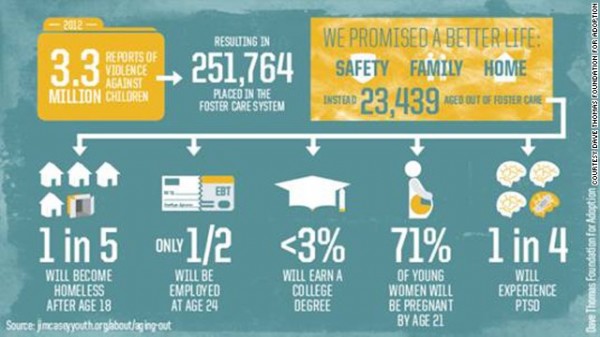The Forgotten: Aging Out of the Foster Care System
One of the most difficult phases of a child’s life is that of being a teenager. There are pressures from everywhere – parents, teachers, friends, and social media. Essentially the whole world has their eyes on them. And as parents, we want nothing more than to teach our children to have healthy relationships, do their best in school, and to learn essential life skills that will carry them through life. It is our job to nurture and guide them, to prepare them for life. It is critical that parents spend the time teaching their children how to be successful in life, work and relationships. But even with all of our best efforts as parents, we have no certainty as to how our children will interact with the world when it is time for them to spread their wings and fly on their own. Odds are against them every single day as this world pulls them in a million different directions.
Now imagine sending an adolescent into the world without having been taught any of those life skills – how to love, make decisions, or what doing their best looks like. Or imagine your child(ren) growing up and not knowing how to hug another person, play with other children, or even basic scholastic skills. What if we sent our child(ren) out into the world without teaching them anything? What would their lives look like and what would this world look like? Who could do something so inhumane? The answer is we do every single year.
We as a nation send over 20,000 children each year into the world expecting them to succeed in life and provide a contribution to society. This is the number of “the forgotten.” This is the number of those that have turned 18 and aged out of our foster care system*. This is the number of faces that are looking to the world, our world, to be accepted and loved. This is the number that has waited their entire lives to have a family. This is the number that contributes to one third of the nation’s teenage homeless population**. And this number is only rising.

(courtesy of Jim Casey Youth Org)
I don’t know about you, but these numbers make me cringe. These are not numbers from a third world country. They are taken out of our own backyards, neighborhoods, cities, states, and nation. “The forgotten” is real group of children – the defenseless of the world.
So what can you and I do to help “the forgotten?” The first step is to recognize that there is an actual problem in this country. The second is to look within ourselves to ask what we can do to make a difference. For some that may look like adopting a child that has aged out of foster care. To provide them with love, nourishment, stability, home, and a family that they never had. To others it may simply be giving of your time or financial resources to organizations that assist these young adults in teaching them essential life skills so that they don’t wind up in jail, homeless, or worse. Or it may be simply advocating or supporting those that are providing those tangible needs. The point is that we all have a role and even though we may not be able to eliminate “the forgotten” population of young adults, we can all work together to ensure less young adults go into this world feeling forgotten. They haven’t asked for any of this. They have only asked for a family to love them.
* Statistic from 2013 AFCARS (Adoption and Foster Care Analysis and Reporting System), United States Department of Health and Human Services, Administration for Children and Families, Administration on Children, Youth, and Families, Children’s Bureau (www.acf.hhs.gov)
** Statistic from www.covenanthouse.org






